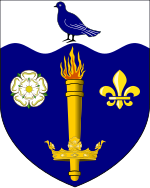Hull Grammar School
1330s establishments in England14th-century establishments in England2015 disestablishments in EnglandDefunct schools in Kingston upon HullEducational institutions disestablished in 2015 ... and 2 more
Educational institutions established in the 14th centuryUse British English from February 2023
Hull Grammar School was a secondary school in Hull, England, founded around 1330 and endowed in 1479 by the prelate John Alcock. In 1988, as part of a restructure by the Local Education Authority, the site was renamed William Gee School. Meanwhile, Hull Grammar School relocated to the old Marist College site on Cottingham Road, becoming a fee paying school in 1989, only to merge with Hull High School in 2005 to form the Hull Collegiate School (renamed in 2021 Tranby School).
Excerpt from the Wikipedia article Hull Grammar School (License: CC BY-SA 3.0, Authors).Hull Grammar School
Scholars Drive, Hull Avenues
Geographical coordinates (GPS) Address Nearby Places Show on map
Geographical coordinates (GPS)
| Latitude | Longitude |
|---|---|
| N 53.76812 ° | E -0.36207 ° |
Address
Scholars Drive
HU5 2DB Hull, Avenues
England, United Kingdom
Open on Google Maps











